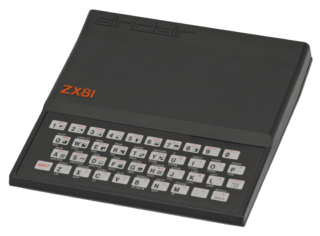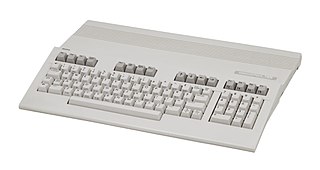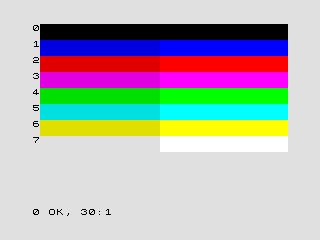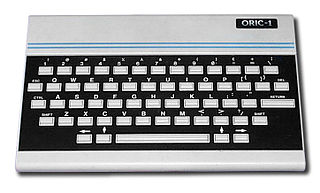
The Amstrad CPC is a series of 8-bit home computers produced by Amstrad between 1984 and 1990. It was designed to compete in the mid-1980s home computer market dominated by the Commodore 64 and the ZX Spectrum, where it successfully established itself primarily in the United Kingdom, France, Spain, and the German-speaking parts of Europe.

The Jupiter Ace by Jupiter Cantab was a British home computer of the early 1980s. The Ace differed from other microcomputers of the time in that its programming environment used Forth instead of the more popular BASIC.
The Sinclair QL is a personal computer launched by Sinclair Research in 1984, as an upper-end counterpart to the ZX Spectrum. The QL was aimed at the serious home user and professional and executive users markets from small to medium-sized businesses and higher educational establishments, but failed to achieve commercial success. While the ZX Spectrum has an 8-bit Zilog Z80 as the CPU, the QL uses a Motorola 68008. The 68008 is a member of the Motorola 68000 family with 32-bit internal data registers, but an 8-bit external data bus.

The Sinclair ZX80 is a home computer launched on 29 January 1980 by Science of Cambridge Ltd.. It is notable for being one of the first computers available in the United Kingdom for less than a hundred pounds. It was available in kit form for £79.95, where purchasers had to assemble and solder it together, and as a ready-built version at £99.95.

The ZX Spectrum is an 8-bit home computer that was developed by Sinclair Research. It was released in the United Kingdom on 23 April 1982, and became Britain's best-selling microcomputer.

The ZX81 is a home computer that was produced by Sinclair Research and manufactured in Dundee, Scotland, by Timex Corporation. It was launched in the United Kingdom in March 1981 as the successor to Sinclair's ZX80 and designed to be a low-cost introduction to home computing for the general public. It was hugely successful; more than 1.5 million units were sold. In the United States it was initially sold as the ZX-81 under licence by Timex. Timex later produced its own versions of the ZX81: the Timex Sinclair 1000 and Timex Sinclair 1500. Unauthorized ZX81 clones were produced in several countries.

The Commodore 128, also known as the C128, C-128, C= 128, is the last 8-bit home computer that was commercially released by Commodore Business Machines (CBM). Introduced in January 1985 at the CES in Las Vegas, it appeared three years after its predecessor, the Commodore 64, the bestselling computer of the 1980s.

The SAM Coupé is an 8-bit British home computer manufactured by Miles Gordon Technology (MGT), based in Swansea in the United Kingdom and released in December 1989.

Locomotive Basic is a proprietary dialect of the BASIC programming language written by Locomotive Software on the Amstrad CPC and the later Locomotive BASIC-2 as a GEM application on the Amstrad PC1512 and 1640. It was the main descendant of Mallard BASIC, the interpreter for CP/M supplied with the Amstrad PCW.
Sinclair BASIC is a dialect of the programming language BASIC used in the 8-bit home computers from Sinclair Research and Timex Sinclair. The Sinclair BASIC interpreter was made by Nine Tiles Networks Ltd.

The Timex Sinclair 1000 was the first computer produced by Timex Sinclair, a joint venture between Timex Corporation and Sinclair Research. It was launched in July 1982, with a US sales price of US$99.95, making it the cheapest home computer at the time; it was advertised as "the first computer under $100". The computer was aimed at regular home users. As purchased, the T/S 1000 was fully assembled and ready to be plugged into home televisions, which served as a video monitor. The T/S 1000 was a slightly modified version of the Sinclair ZX81 with an NTSC RF modulator, for use with North American TVs, instead of PAL for European TVs. The T/S 1000 doubled the onboard RAM from 1 KB to 2 KB; further expandable by 16 KB through the cartridge port. The T/S 1000's casing had slightly more internal shielding but remained the same as Sinclair's, including the membrane keyboard. Just like the ZX81, the T/S 1000 had black-and-white graphics and no sound.

The Timex Sinclair 2068, released in November 1983, was Timex Sinclair's third and last home computer for the United States market. It was also marketed in Canada, Argentina, Portugal and Poland, as Timex Computer 2068.
The Didaktik was a series of 8-bit home computers based on the clones of Intel 8080 and Zilog Z80 processors produced by Didaktik in Skalica, in the former Czechoslovakia.

The Enterprise is a Zilog Z80-based home computer announced in 1983, but through a series of delays, not commercially available until 1985. The specification as released was powerful and one of the higher end in its class. This was due to the use of ASICs for graphics and sound which took workload away from the CPU, an extensive implementation of ANSI BASIC and a bank switching system to allow for larger amounts of RAM than the Z80 natively supported. It also featured a distinctive and colourful case design, and promise of multiple expansion options. Ultimately it was not commercially successful, after multiple renames, delays and a changing market place. Its manufacturer calling in the receivers in 1986 with significant debt. It was developed by British company Intelligent Software and marketed by Enterprise Computers. Its two variants are the Enterprise 64, with 64 kilobytes of Random Access Memory (RAM), and the Enterprise 128, with 128 KB of RAM.

Hobbit is a Soviet/Russian 8-bit home computer, based on the ZX Spectrum hardware architecture. Besides Sinclair BASIC it also featured CP/M, Forth or LOGO modes, with the Forth or LOGO operating environment residing in an on-board ROM chip.

The TRS-80 Model 100 is a portable computer introduced in April 1983. It is one of the first notebook-style computers, featuring a keyboard and liquid crystal display, in a battery-powered package roughly the size and shape of a notepad or large book.

The original ZX Spectrum computer outputs video through an RF modulator and was designed for use with contemporary 1980s television sets, for a simple colour graphic display.

The ZX Spectrum character set is the variant of ASCII used in the ZX Spectrum family computers. It is based on ASCII-1967 but the characters ^, ` and DEL are replaced with ↑, £ and ©. It also differs in its use of the C0 control codes other than the common BS and CR, and it makes use of the 128 high-bit characters beyond the ASCII range. The ZX Spectrum's main set of printable characters and system font are also used by the Jupiter Ace computer.

Oric was the name used by UK-based Tangerine Computer Systems for a series of 6502-based home computers sold in the 1980s, primarily in Europe.
















